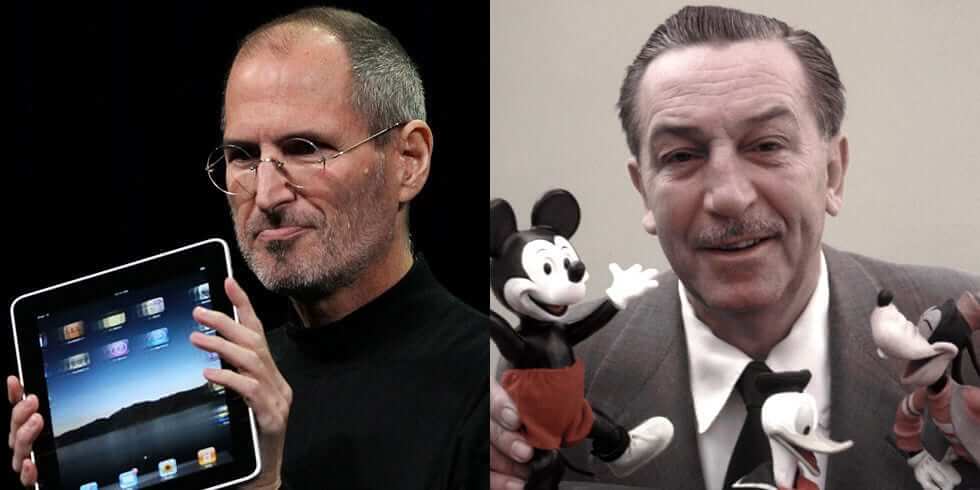There is an awful lot one can learn from the remarkable Steve Jobs, of course, but one thing stands out to me–one single thing that can get lost among the many lessons his story offers: Failure.
The people who change the world are not brighter than everyone else is; there are many bright people with great ideas. It isn’t that Steve had vision; when I worked in the Bay Area, I found I couldn’t take a dozen steps without running into someone with an exciting vision for the future. And it isn’t that Steve better focused on the needs of humans; that is certainly an integral part of his success, but every organization is full of people capable of putting customers first.
No, the one thing that sets Steve Jobs apart from others is not success but failure. Reading his biographies and tributes this week reminded me of another hero of mine, Walt Disney. Their tales are remarkably similar in many ways.
We Americans have a terrible habit of distilling the stories of our great men and women into simplified and boring soundbites of success–Walt Disney invented Mickey Mouse! Steve Jobs invented the iPad!–while ignoring the long, crooked, difficult, brave roads they took to realize that success. We like to believe that success is what defines the American spirit, but the truth is the opposite: Failure is what defines the people who achieve greatness.
Steve Jobs and Walt Disney are American success stories–and they both failed in spectacular fashion. Steve Jobs produced the Apple III, a computer with so many hardware issues that one of the solutions (I’m not kidding) was to drop the computer two inches to reseat the chips on the motherboard. Walt Disney’s first animation effort went bankrupt and he lost the rights to his first commercially successful character (the forgotten Oswald the Lucky Rabbit.)
For most, the story would have ended there. Steve Jobs, pushed out of the very company he founded, could have spent his life developing products that didn’t push the envelope but delivered his family a very comfortable standard of living. Walt Disney could have given up animation–something he’d briefly attempted in the past–and sought work in the booming Hollywood movie business. But neither did–they learned from failure and eagerly dove back into the deep end of the risk pool. Said Steve Jobs, “It turned out that getting fired from Apple was the best thing that could have ever happened to me… Sometimes life hits you in the head with a brick. Don’t lose faith.”
What is remarkable about both Steve Jobs and Walt Disney isn’t merely that they persevered after failure; instead, the defining characteristic of these great men–the one thing we can and should learn from Jobs and Disney–is that they never stopped embracing risk even after they achieved success. It is difficult enough to make risky decisions after one is prosperous and comfortable, but imagine making those same risky decisions after having suffered the kind of confidence-shaking flameouts that Jobs and Disney experienced.
Disney achieved great success and recognition with Mickey Mouse, Donald Duck and The Three Pigs, yet he risked it all to push his company into the dangerous and untested waters of full-length animated movies. He was forced to release “Snow White” sooner than he wanted when the banks funding what had come to be known as “Disney’s Folly” refused to advance any more credit. Snow White earned Walt money and recognition, yet he risked it again and again on pet animation projects, live-action films and the riskiest bet of all–theme parks. Having tasted the bitter pill of failure, he nonetheless risked his reputation and wealth frequently.
Steve Jobs did the same. After being dumped from the company he founded, Jobs turned his attention to new risky endeavors. He launched a new software company called NeXT, Inc. and invested $50 million of his own money into Pixar. NeXT floundered, Pixar soared and Jobs was soon back at the helm at Apple. For most of us, the satisfaction and recognition of a triumphant return to the company that dumped us would be validation enough, yet Jobs took a salary of $1 a year and repeatedly placed risky bets on new business models and innovative technology. Jobs might have stopped at any point in his journey and retired with the kind of wealth and accolades most can only dream of, yet his risks and hits kept coming–iMac, Macbook Air, iPod, iTunes, iPhone and the iPad.
Most within corporate America work their entire careers avoiding risk. Some do it blatantly, taking pride in saying “no” to anything new that comes along, protecting the bottom line and corporate reputation from anything that feels a little dicey. Others avoid risk superstitiously, hiding behind focus groups, best practices and spreadsheets that promise (but rarely deliver) ROI.
In Human Resource departments, for example, the risk avoiders hire only candidates who present excellent education records; Steve Jobs dropped out of college and Walt Disney left high school after one year. In Marketing Departments, the risk avoiders spend big money on TV and print while moving cautiously into digital and social; Disney made huge bets before others on Technicolor in movies and on the nascent television medium, and Steve Jobs doubled down on mobile computing at a time when few expressed a desire for expensive mobile devices.
Avoiding risks doesn’t get someone fired. No one is ever called into a senior executive’s office to justify why he or she declined to invest the company’s money in a bold but untested idea. The risk avoiders rise slowly and steadily in corporate ranks, producing modest results. They never risk their reputations or career achievement, and when they fail, they fail small and justifiably–“The creative tested well!” or “The candidate had a great GPA from a respected school!”
Most of the time, these people guide companies to outcomes within a safe and expected range, perhaps stealing a point of market share from the competition. Little is risked, lost or gained. But the road to failure is paved with a thousand tiny successes, and while risk avoiders don’t fail spectacularly, their companies can. Risk avoiders cannot change quickly enough; they miss threats to their marketplace and are unable to rapidly steer a new course. Blockbuster, Borders, GM, and many other firms were full of risk avoiders who were constantly and modestly successful until they suddenly were not.
Of course, there are many in corporate America who embrace risk, but few do so like Jobs and Disney. If you are a risk taker, you probably do so only part way. You likely don’t bet your job, your home and your family’s future on your vision. Walt Disney would have lost Mickey Mouse and his home had Snow White failed, and he later borrowed against his own life insurance policy to fund the construction of Disneyland. You don’t take that kind of risk, and neither do I.
How much are you willing to risk failure? After being promoted and earning a healthy income, are you inclined to put that at risk to pursue your vision and deliver exceptional results for your employer? Can you defend and support an employee’s new idea when their last one failed thoroughly?
The lessons of Walt Disney and Steve Jobs aren’t simple or easy. Very few of us have the power to achieve anything close to their level of greatness, but the way we choose to view failure and our willingness to risk what we have achieved is, in my opinion, the defining difference between those who are merely successful and those who bring vital change to their organizations.
Most of us desire success and fear failure. What the stories of Jobs and Disney tell me is that we ought to embrace failure and fear success. The more we succeed and achieve, the less likely we become to accept risks. Jobs and Disney remind me of a Steinbeck quote–one I learned from Epcot’s American Adventure (Thanks, Walt!) Steinbeck was speaking of our nation, but he may have well been speaking to every company and individual who has tasted success:
We now face the danger which in the past has been the most destructive to nations. Success, plenty, comfort and ever-increasing leisure: no dynamic people have ever survived these dangers.
Think Different, indeed!
This article was written and produced by Experience The Blog, an informative business blog. see more.





























